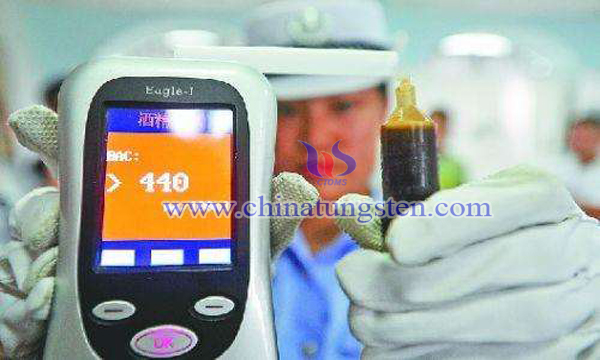New Manufacture Process for Tungsten-Oxide Ethanol Sensor
- Details
- Category: Tungsten Information
- Published on Monday, 23 July 2018 18:37
The ethanol gas sensor can detect the ethanol content in drunk driving inspection or industrial production, So as to reduce or avoid traffic accidents or production safety accidents. In recent years, the development of ethanol sensors has become more extensive and in-depth, and the ethanol sensing characteristics of tungsten oxide have received extensive attention from researchers.

At present, the ordinary electrochemical of tungsten-oxide ethanol sensor has technical problems of high working temperature, complicated processing of the device, and being easily interfered by external electromagnetic fields. In order to change this situation, and popularized the tungsten oxide ethanol sensor. Some scholars have improved it. The manufacturing process of the sensor are as following steps:
1) Preparation of tungsten oxide nanorods by hydrothermal method: under the condition of magnetic stirring, a solution of 2 mol/L aqueous sulfuric acid is added dropwise to a solution of 0.1 mol/L to 0.2 mol/L of Na2(WO4)·2H2O aqueous solution. The pH is from 1 to 1.5, stirred for 30 min to 40 min, and (NH4)2SO4 and oxalic acid are added under magnetic stirring, stirred for 30 min to 40 min, and then transferred to a hydrothermal reaction kettle at a temperature of 180 ° C to 200 ° C. After reacting for 10 h, the product obtained by hydrothermal treatment was washed 3 times with deionized water, then washed 3 times with ethanol, and dried at a temperature of 80 ° C for 4 h to obtain an optical temperature sensing material tungsten oxide nanorod powder; The molar ratio of (NH4)2SO4 to Na2(WO4)·2H2O is 1: (0.11 to 0.13); the molar ratio of oxalic acid to Na2(WO4)·2H2O is 1: (0.36 to 0.37);
2) Preparation of a tungsten oxide gas sensing element: the optical temperature sensing material tungsten oxide nanorod powder prepared in the first step is dispersed in a solvent to obtain a tungsten oxide solution of 0.01 mol/L to 0.1 mol/L, and 25 μL of the solution is obtained. 100 μL of 0.01 mol/L to 0.1 mol/L tungsten oxide solution is uniformly coated on the substrate, dried at a temperature of 60 ° C to 100 ° C for 30 min to 60 min, and then subjected to argon plasma cleaning or argon gas. Annealing in the atmosphere to obtain a tungsten oxide gas sensing element; the argon plasma cleaning power is 10W to 50W, the cleaning time is 5min to 30min; and the annealing temperature in the argon atmosphere is 200°C~ 400 ° C, annealing time is 1h; the size of the substrate is 8mm × 12mm;
3) Install a stainless steel cavity in the fluorescence spectrometer, place the tungsten oxide gas sensing element into the stainless steel cavity installed in the fluorescence spectrometer, and install an electronic heating under the tungsten oxide gas sensing element in the stainless steel cavity. The device seals the stainless steel cavity and then commissions the electronic heating device. After a series of debugging, the gas sensor is completed.
The above-mentioned tungsten oxide gas sensor device is simple in processing, does not require an electrode processing process in electrical equipment processing, does not require the conductivity inside the tungsten oxide sample, and does not require the processing process of the temperature measuring component of the heating component in the processing of the electrical device. It is free from electromagnetic interference and can work at room temperature, and enables remote operation, which higher applicability.
- Tungsten Oxide Manufacturer & Supplier, Chinatungsten Online: www.tungsten-oxide.com
- Tungsten News & Prices of China Tungsten Industry Association: www.ctia.com.cn
- Molybdenum News & Price: news.molybdenum.com.cn
- Tel.: 86 592 5129696; Fax: 86 592 5129797; Email: sales@chinatungsten.com



 sales@chinatungsten.com
sales@chinatungsten.com